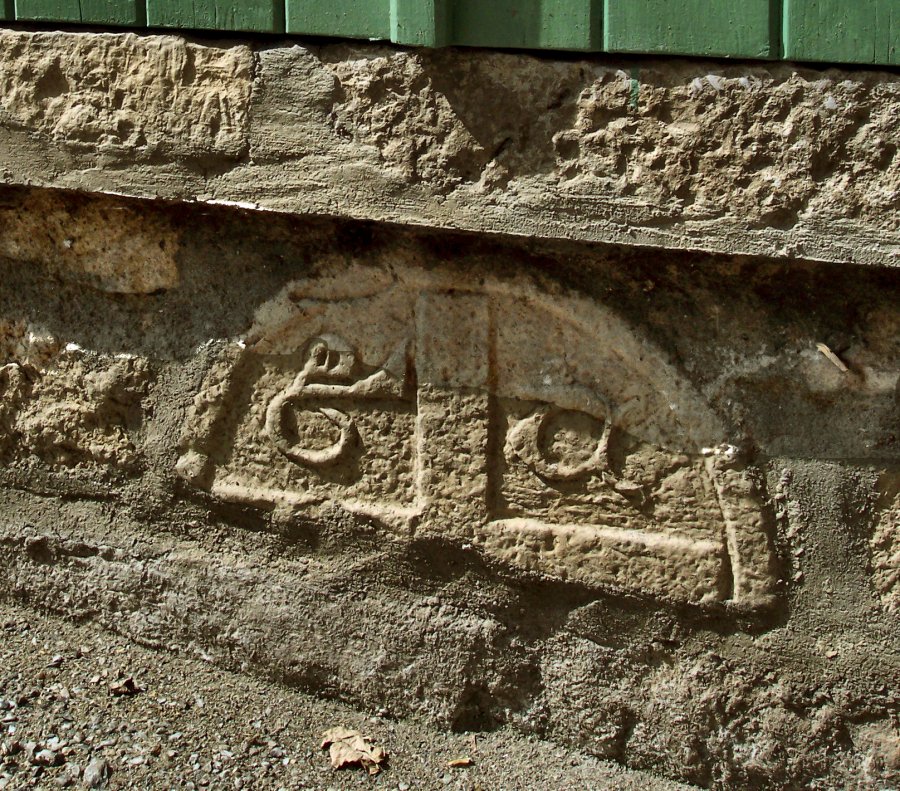
The above sandstone fragment
is built into a wall, under a doorway in the rue Volgues.
I believe it to be the
oldest surviving remnant of the 9th century abbey.
Crosses like this are
to be found throughout the area covered by the Roman Empire - and, indeed,
beyond:
for example, in Ireland.
According to (propagandistic)
legend, the fourth-century Emperor Flavius Constantius
(Constantine the Great)
had a dream before a battle with his rival Maxentius at the Pontus-Milvius
bridge
(today's Ponto-Milvio north of Rome) :
Jesus showed him a magic monogram blazing in the sky, and announced:
"With this symbol you will conquer!" (en touto nika in
Greek,
In
hoc signo vinces in Latin.)
In fact, Constantine wasn't
definitively converted to Christianity until he lay dying.
It was his mother, Helen, who was a (less than humble) convert to the
new religion.
(Humility is perhaps the least common virtue amongst believers.)
The exact form of the
apparition is not entirely clear - apart from the presence
of the two Greek letters X (Chi) and P (Rho) which are the initial letters
of CHRistos,
with or without the Alpha and Omega: 'I am the beginning and the
end' [of everything].
The ancient Greeks used the symbol as an abbreviation of the word CHRESIMON
(useful thing) to mark interesting passages in texts.
Later, this Chi-Rho was adopted by Christians, most likely before the
reign of Constantine.
read
more (in French)

Note also this coin from Republican Rome struck by Manlius (circa
107 BCE)
showing the sun, the moon and the 'celestial intersection' of
Platonism:
an X representing the entrance to the Perfect World of the Forms.
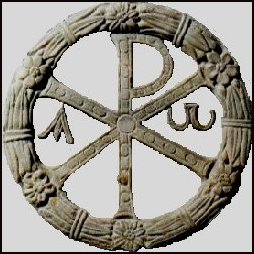
The motif, known as Labarum (standard), was adapted and adopted
to be put on legionaries' shields,
as a sign of the Church Militant in the Eastern part of the Empire -
which was split in two by Constantine
- and also in those Western parts invaded by the Visigoths - and even
in Ireland,
a country never part of the Roman Empire.
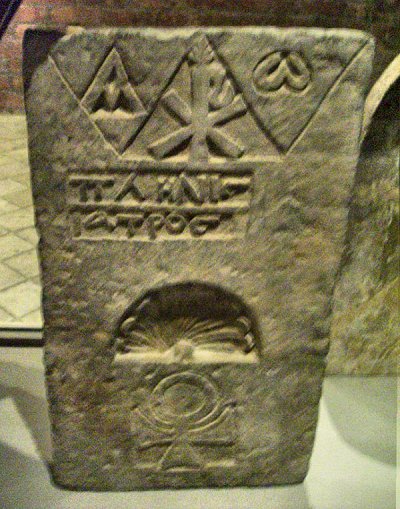
Metropolitan Museum, New-York : Byzantine stele from Egypt,
VI°-IX° century, with Coptic inscription: Pliny the Doctor.
Note the Ankh below - ancient symbol of eternal life.
Note also that the omega is almost always in lower-case [w]
while the alpha is usually upper-case.
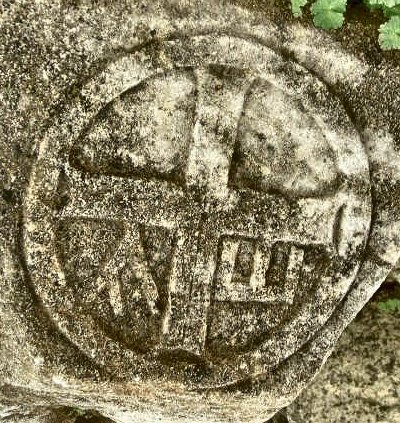
Bylis (Ballsh), Albania :
alpha and omega hanging from the arms of a Greek cross.
VI°-IX° centuries.
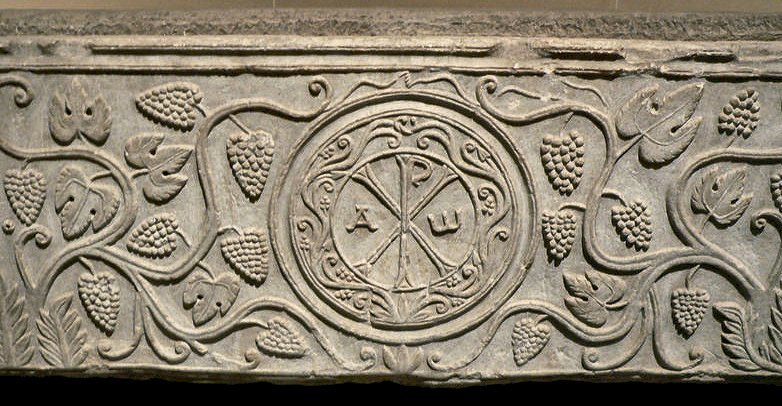
Musée du Louvre : Sarcophagus of Drausin, Soissons (Aisne)
, marble, VI° century:
decorated with a Chrism, alpha + omega, and vine-tendrils.
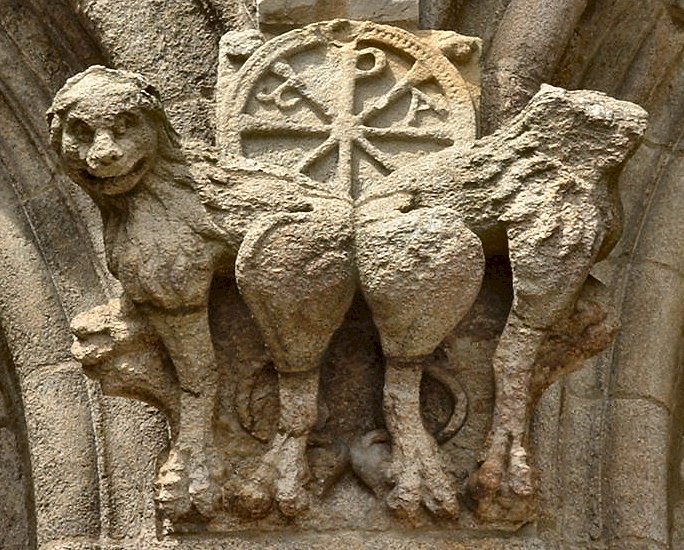
Santiago de Compostella : Puerta de las Platerias - early
Christian or Visigothic sculpture
(V°-VIII° century re-used ?) Notice how the omega has been deformed.
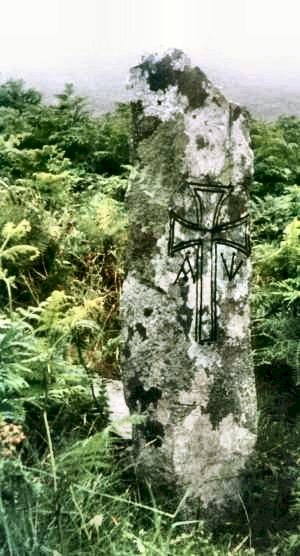
Kildreenagh, Loher ( Kerry), Ireland :
incised cross-pillar with alpha and omega, but no chrism.
VI°-VII° century.
|
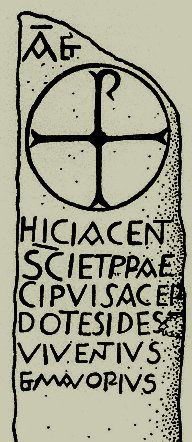
Kirkmadrine (Dumfries & Galloway) Scotland:
funerary stele V°-VI° century: omega already fairly deformed.
|
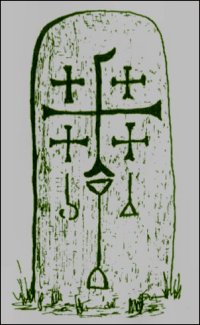
Cloonlaur (Mayo) Ireland:
funerary pillar V°-VI° century: omega and alpha, reversed
and suspended, and even more deformed, with the rho reduced
almost to a mere triangle.
|
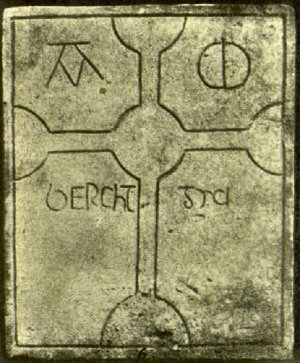
Hartlepool (Tees-side) Englandf:
funerary pillar V°-VI° century: upper-case omega seriously
deformed, with an inscription in "Hiberno-Saxon" lettering:
BERCHTGRA.
|
|
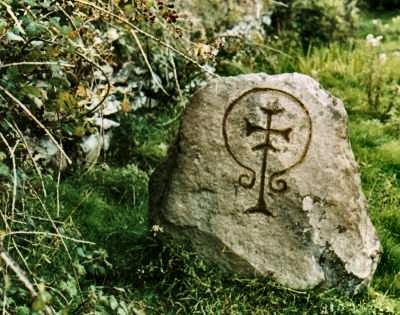
Kilvickadownig ( Kerry), Ireland :
incised boulder with abstract rendering of the Chrism and Alpha-Omega.
The cross-pattée is the X , surrounded by a halo which
forms the P reflected as in a mirror..
The curlicues are the abstract deformation of both alpha and omega.
The large halo-circle could also be an upper-case omega!
VI°-VII° century.
|
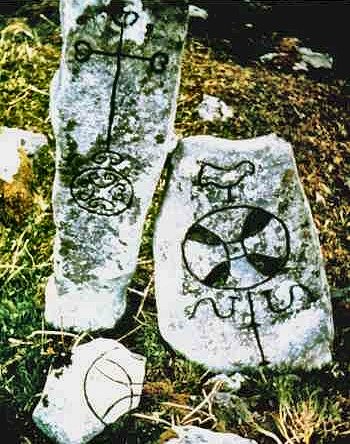
Caherlehillan (Kerry), Irlande :
the cross-slabon the right has an advanced form of a cross in
a circle, on which stands a crude bird
(peacock : symbol of immortality, or maybe a dove).
Below the cross-in-a-circle are two decorations which could
represent snakes, or abstract renderings of alpha and omega.
VI°-VII° century.
|
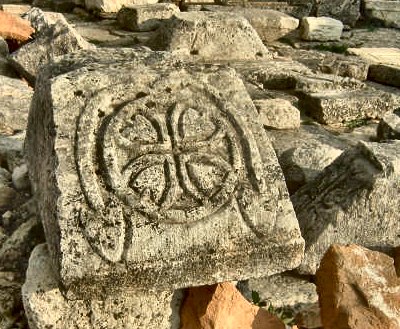
Bylis (Ballsh), Albania:
a cross within a circle enclosed by snakes,
symbol of Mother Earth which is found frequently in pre-Gothic Christian
art.
V°-VII° centuries.
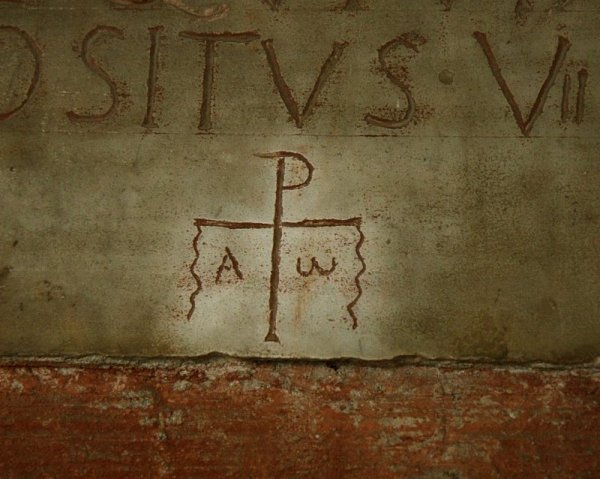
Rome: San Lorenzo Fuori degli Muri : Chrism with serpents
which look more like chains,
with alpha and omega not suspended, but hanging in space.
V° century.
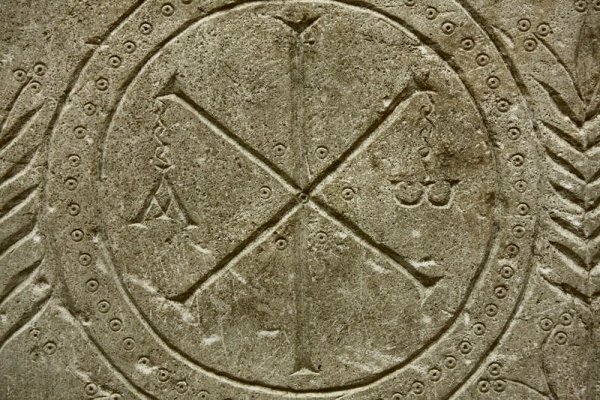
Bonn (Nordrhein-Westphalen), Germany:
detail of a funerary slab of a certain Rignedrudis
with the alpha in upper-case and the oméga in lower-case, both
hanging from chains.
The Rho is missing.
VI° century.
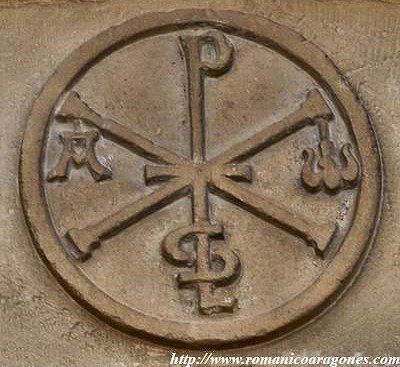
Olcoz (Navarra, Spain ): alpha and omega suspended,
and a serpent which coils around the base of the rho.
Note that a bar has been added between the arms of the chi to form a
normal cross.
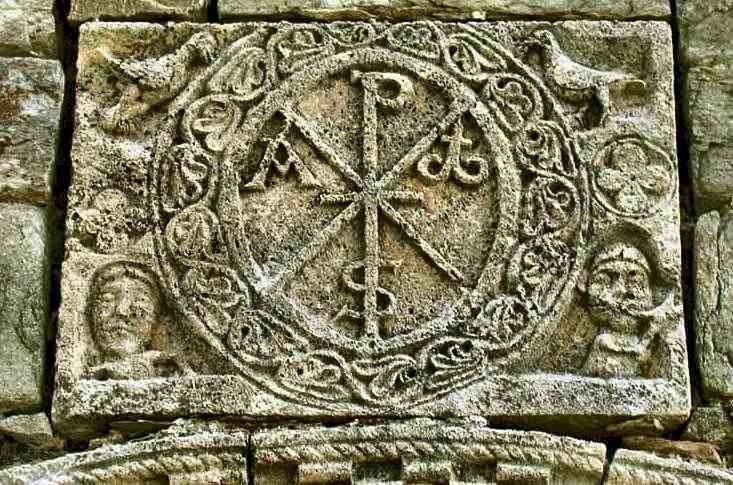
Bas-relief more elaborate at Coll de Nargó (Lleida)
in the Spanish Pyreneess:
the serpent has degenerated into a capital S !
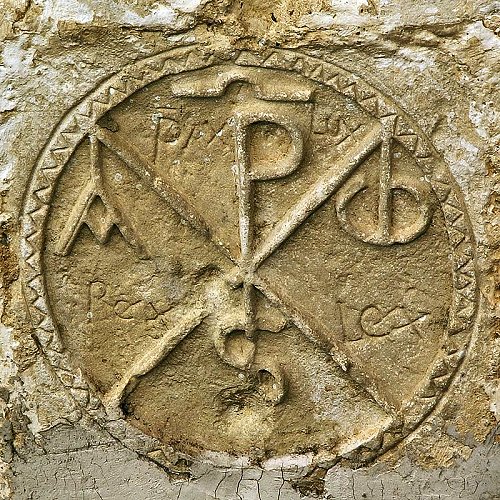
Church of Saint-Pierre, Simacourbe (Pyrénées-Atlantiques).
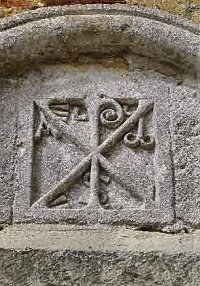
XII century tympanum, Violles (Hérault) :
the omega is almost phallic!
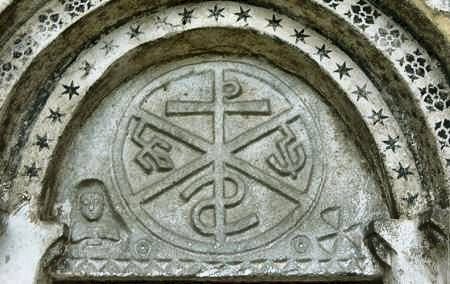
XIII century tympanum at Mont (Hautes-Pyrénées)
: the alpha and omega are almost unrecognisable.
The frequency of Chrisms in the south-west of France suggest that they
challenge 'Catharism',
which eschewed the building of churches, and the sculpture and esoteric
symbolism of syncretic Catholicism.
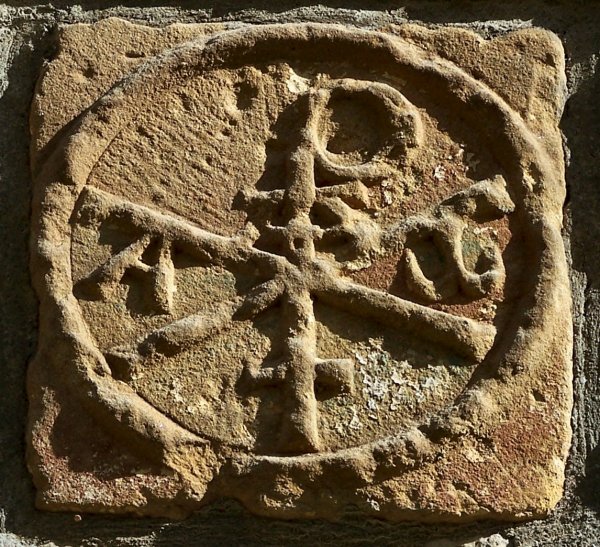
On a single stone above the door of the south-Pyrenean chapel of
the monastery of Obarra (Aragón)
the serpent has become the arm of a cross, and another arm forms a cross
just below the misshapen Rho.
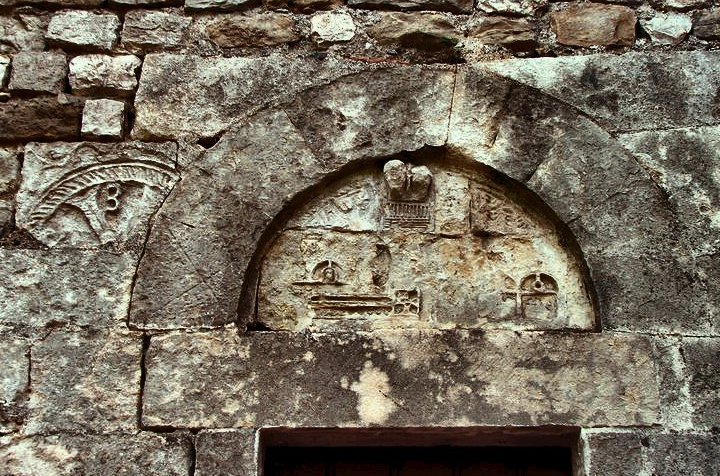
Viviers (Ardèche), Chapelle Saint-Ostian:
The S door features this strange tympanum, echoed on the left
by a fragment of chrismed cross-head with a perfect lower-case omega.
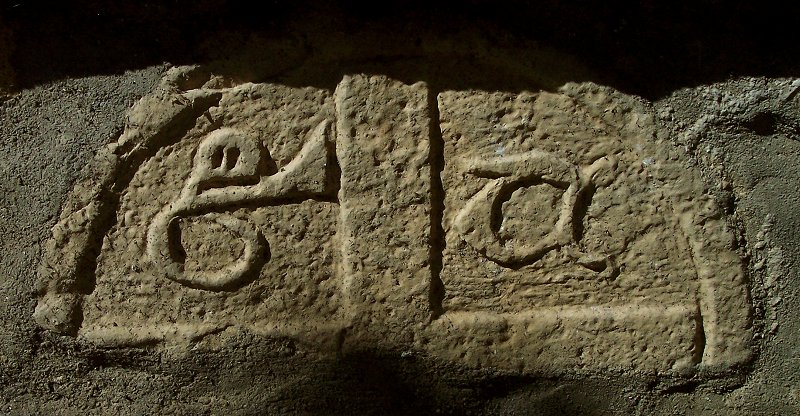
Saint-Antonin-Noble-Val (Tarn-et-Garonne) :
alpha and omega reversed, the omega looking like a horn...or a snake...or...?
VI°-IX° centuries: Visigothic or Merovingian.
The alpha is very rarely in lower case, as it is here.
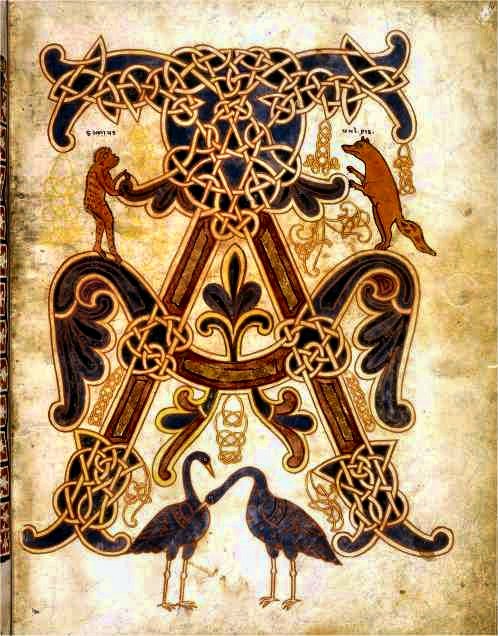
Manuscript of the Apocalypse (book of Revelations),
known as the Béatus de Saint-Sever (Landes), folio
14 :
alpha and omega very stylised and highly decorated.

Doors and Doorways 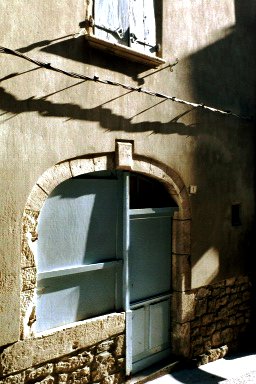 of St-Antonin-Noble-Val
of St-Antonin-Noble-Val

Prhistoric sites around Saint-Antonin:
Dolmens
de Saint-Antonin >
Roussayrolles
>
Saint-Cirq
>
Septfonds
>
Vaour,
Verdier
(Sainte-Cécile),
Vieux
>
Grotte
de la Magdaleine des Albis
>
'Le Chemin des Neuf Pierres'
(Nine-stones Way)
suggests that there might once have been an alignment or stone-row
in the Wagnerian amphitheatre of Saint-Antonin,
which is dominated by several megalithic tombs
on the causse above.
Stone-rows
are not unknown in Rouergue...
Satan in the Groin : images of sin on Romanesque churches

